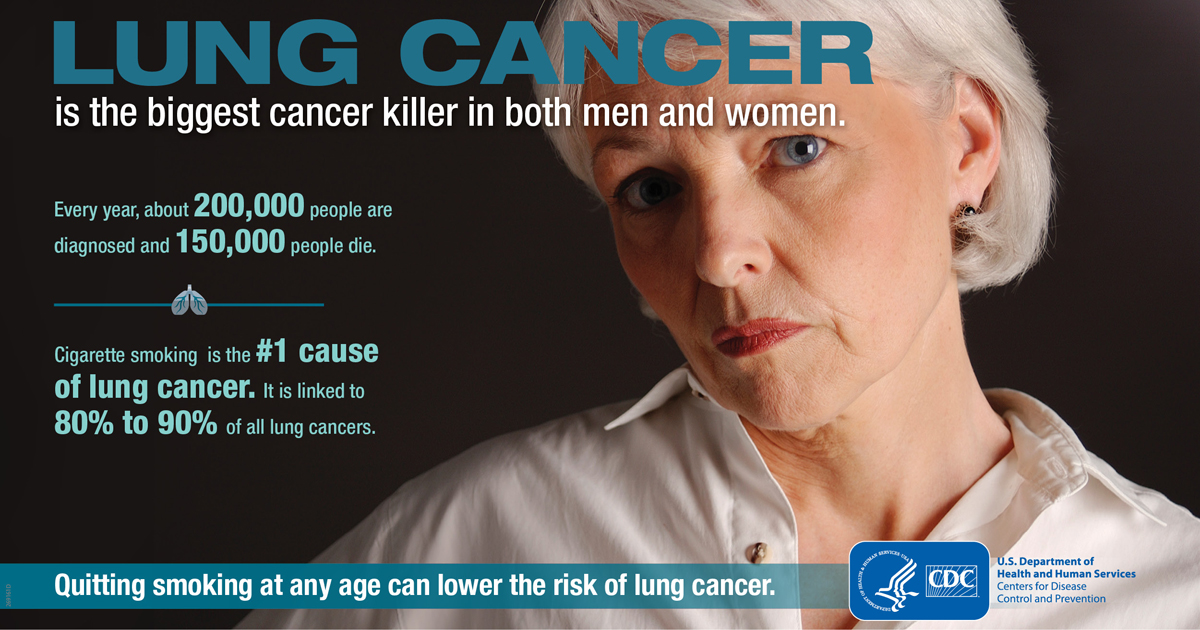- Cancer Division Home
- Cancer Control Coalition
- ASCR
- Breast & Cervical Cancer (ABCCEDP)
- Alabama WISEWOMAN Program
- Cancer State Plan
- Publications
- Print Material
- Breast Cancer
- Cervical Cancer & OPERATION WIPE OUT
- Colorectal Cancer
- Lung Cancer
- Prostate Cancer
- Skin Cancer
- Survivorship: Life During and After Cancer
- HPV: Cervical Cancer Prevention
- Nutrition and Physical Activity
- Contact Us
SEE ALSO:
Cardiovascular Health
Diabetes
Nutrition and Physical Activity
Oral Health
Tobacco Prevention/Quitline
NEED HELP?
Having trouble finding what you are looking for? Use our A to Z Index.
Lung Cancer
Lung cancer is the second most common cancer in both men and women (not including skin cancer), and is by far the leading cause of cancer deaths among both men and women. Each year, more people die of lung cancer than of colon, breast, and prostate cancers combined. About 13% of all new cancers are lung cancers. Lung cancer mainly occurs in older people over the age of 65. The average age of diagnosis is about 70.
Most lung cancers have already spread widely and are at an advanced stage when they are first found. These cancers are very hard to cure. But in recent years, doctors have found a test, low-dose computed tomography (also called a low-dose CT scan, or LDCT), that can be used for lung cancer screening in people at high risk of the disease. This test can help find some of these cancers early, which can lower the risk of dying from this disease.
New USPSTF Recommendation for CTLS Lowers Age and Pack Year Requirement
March 9, 2021 the United States Preventive Services Task Force (USPSTF) announced revisions to its existing lung cancer screening recommendation, which lowers the screening age and incorporates patients with a shorter smoking history. The USPSTF update recommends annual lung cancer screening with low-dose computed tomography in individuals at high risk:
- 50-80 years old
- Have at least a 20 pack year smoking history
- Are currently smoking or quit within the past 15 years
This recommendation essentially doubles the number of individuals eligible for CT lung screening in the U.S. The expanded recommendation will also help to narrow the disparities that have existed in CT lung screening, especially among women and minorities, particularly Black males and Native Americans.
Cigarette smoking is the number one cause of lung cancer. Lung cancer also can be caused by using other types of tobacco (such as pipes or cigars), breathing secondhand smoke, being exposed to substances such as asbestos and radon at home or work, and having a family history of lung cancer. Smoking rates in the United States have been driven down by health concerns, increasing regulations, higher prices, and changing social norms. However, the use of alternative tobacco products, especially e-cigarettes have become more popular. E-cigarettes can resemble traditional tobacco products like cigarettes, cigars, pipes, or common gadgets like flashlights, flash drives, or pens.These products have grown rapidly, particularly among youth and young adults.
According to the American Academy of Pediatrics, e-cigarettes are the most commonly-used tobacco products among youth, and use is rising at an alarming rate. In 2024, 7.8% of high school students and 3.5% of middle school students reported having used e-cigarettes in the last 30 days. Youth use of e-cigarettes is a significant public health concern. Flavorings in tobacco products can make them more appealing to youth.

Tobacco Laws
On December 20, 2019, President Donald Trump signed legislation amending the Federal Food, Drug & Cosmetic Act, raising the federal minimum age of the sale of tobacco products from 18 to 21 years. Under "Tobacco 21" it is now illegal for retailers to sell any tobacco products, including cigarettes, cigars, and e-cigarettes, to anyone under the age of 21. Prior to this change, the minimum age to buy tobacco products in Alabama was 19.
The Stringer-Drummond Vaping Act went into effect on August 1, 2019 limiting access and marketing of vaping products to minors.
The Act requires the following:
- The Alcoholic Beverage Control Board to regulate retail sales of e-cigarettes and vape products
- Advertising cannot categorize vape and other alternate nicotine products as tobacco cessation devices or healthy alternatives to smoking
- Vape shops must have a tobacco permit
- Opening vape shops within 1,000 feet of a school, church, youth center, daycare center, or public library, playground or park is prohibited
Prevention Tips
The two leading causes of lung cancer are tobacco use and radon exposure. You can help lower your risk of lung cancer in the following ways:
- Don’t smoke. Cigarette smoking causes about 90% of lung cancer deaths in the United States. The most important thing you can do to prevent lung cancer is to not start smoking, or to quit if you smoke.
- Avoid secondhand smoke.Smoke from other people’s cigarettes, cigars, or pipes is called secondhand smoke. Make your home and car smoke-free.
- Get your home tested for radon. The U.S. Environmental Protection Agency recommends that all homes be tested for radon.
- Be careful at work. Health and safety guidelines in the workplace can help workers avoid carcinogens—things that can cause cancer.
For more information about radon exposure and testing visit ADPH Radon Program.
Also visit ADPH’s Tobacco Prevention and Control for more information and available resources.
Please visit the CDC " Talk to Someone" virtual simulation Linda for more information on how smoking affects the body, especially as a cancer survivor, and hear advice about quitting.
Additional Resources
Page last updated: September 11, 2025
SEE ALSO:
Cardiovascular Health
Diabetes
Nutrition and Physical Activity
Oral Health
Tobacco Prevention/Quitline
NEED HELP?
Having trouble finding what you are looking for? Use our A to Z Index.




